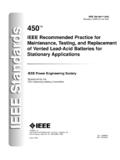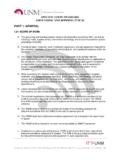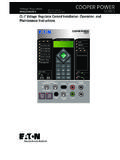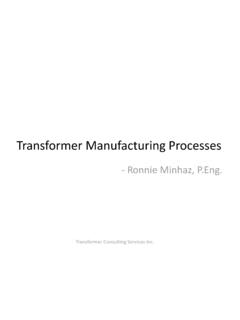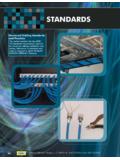Transcription of IEEE Guide for the Selection and Sizing of Batteries …
1 The Institute of Electrical and Electronics Engineers, East 47th Street, New York, NY 10017-2394, USAC opyright 1995 by the Institute of Electrical and Electronics Engineers, rights reserved. Published 1995. Printed in the United States of 1-55937-522-1 No part of this publication may be reproduced in any form, in an electronic retrieval system or otherwise, without the prior written permission of the publisher. ieee Std 1184-1994 ieee Guide for the Selection and Sizing of Batteries for Uninterruptible Power Systems Sponsor Energy Development and Power Generation Committeeof theIEEE Power Engineering Society Approved December 19, 1994 ieee Standards Board Abstract: The characteristics of the various battery energy systems available are described sothat users can select the system best suited to their requirements. This Guide also describes howthe rectifier and the inverter components of the uninterruptible power system (UPS) can relate tothe Selection of the battery system.
2 Keywords: flooded cell, hydrogen evolution, lead-acid battery, nickel-cadmium battery, Plant plate, uninterruptible power system (UPS), valve-regulated lead-acid (VRLA) cell, vented cell ieee Standards documents are developed within the Technical Committees of theIEEE Societies and the Standards Coordinating Committees of the ieee StandardsBoard.
3 Members of the committees serve voluntarily and without are not necessarily members of the Institute. The standards developed withinIEEE represent a consensus of the broad expertise on the subject within the Instituteas well as those activities outside of ieee that have expressed an interest in partici-pating in the development of the of an ieee Standard is wholly voluntary. The existence of an ieee Standarddoes not imply that there are no other ways to produce, test, measure, purchase, mar-ket, or provide other goods and services related to the scope of the ieee , the viewpoint expressed at the time a standard is approved and issued issubject to change brought about through developments in the state of the art and com-ments received from users of the standard. Every ieee Standard is subjected toreview at least every five years for revision or reaffirmation.
4 When a document ismore than five years old and has not been reaffirmed, it is reasonable to conclude thatits contents, although still of some value, do not wholly reflect the present state of theart. Users are cautioned to check to determine that they have the latest edition of anyIEEE for revision of ieee Standards are welcome from any interested party,regardless of membership affiliation with ieee . Suggestions for changes in docu-ments should be in the form of a proposed change of text, together with appropriatesupporting : Occasionally questions may arise regarding the meaning of portionsof standards as they relate to specific applications. When the need for interpretationsis brought to the attention of ieee , the Institute will initiate action to prepare appro-priate responses. Since ieee Standards represent a consensus of all concerned inter-ests, it is important to ensure that any interpretation has also received the concurrenceof a balance of interests.
5 For this reason ieee and the members of its technical com-mittees are not able to provide an instant response to interpretation requests except inthose cases where the matter has previously received formal consideration. Comments on standards and requests for interpretations should be addressed to:Secretary, ieee Standards Board445 Hoes Box 1331 Piscataway, NJ 08855-1331 USAIEEE Standards documents may involve the use of patented technology. Theirapproval by the Institute of Electrical and Electronics Engineers does not mean thatusing such technology for the purpose of conforming to such standards is authorizedby the patent owner. It is the obligation of the user of such technology to obtain allnecessary permissions. iii Introduction (This introduction is not a part of ieee Std 1184-1994, ieee Guide for the Selection and Sizing of Batteries for Uninterruptible PowerSystems.)
6 Our society s increasing dependence on computerized information has resulted in the expanded use ofuninterruptible power systems (UPS) to ensure the integrity of essential power systems. These systemsrequire that stored energy be available to maintain operation. Although rotating inertia has at times beenused to store this energy, Batteries remain the preferred method of energy storage for this array of battery designs and extensive technologies are available to the user. This Guide is intended toinform the user of the various battery technologies available and some of the design points to be consideredwhen selecting a battery for UPS applications. Some of the battery design options that result in volumetricefficiency may also result in reduced life. This Guide can help the user to become aware of which designsand operating procedures can result in optimum battery Guide is intended to be used along with ieee Std 485-1983, ieee Recommended Practice for SizingLarge Lead Storage Batteries for Generating Stations and Substations; ieee Std 484-1987, IEEER ecommended Practice for installation design and installation of Large Lead Storage Batteries forGenerating Stations and Substations; ieee Std 450-1995, ieee Recommended Practice for Maintenance,Testing, and Replacement of Vented Lead-Acid Batteries for Stationary Applications.
7 And ieee Std 1106-1987, ieee Recommended Practice for Maintenance, Testing, and Replacement of Nickel-CadmiumStorage Batteries for Generating Stations and Guide was prepared by the Task Force on Battery/UPS Interface, a sub-organization of the StationBatteries Working Group, Station design Subcommittee of the Energy Development and Power GenerationCommittee of the ieee Power Engineering Society. At the time this Guide was approved, the Task Force hadthe following membership: W. T. Rutledge, Chair C. H. Krieger, Vice Chair Ladislav F. BednarJ. G. GodbyBrian W. PeticolasRichard A. BednarikRichard A. GrecoHorst PfendtJack H. BellackBruce G. HorowitzBradford M. RadimerRichard T. BolgeoSharad C. KhamamkarEric C. RoseenKathryn BullockManfred LaidigThomas E. RuhlmannJoseph A. CristinoAlan L. LambSaba N. SabaTom ChilcoteDan S. LevinVictor W. SokolskiThomas CrodaGary J. MarkleEdward C.
8 StallingsPeter J. DeMarJames A. McDowallMartin M. StantonRamesh DesaiGary MiltonJames E. StaudacherDavid O. FederJ. F. NesticoFrank L. TarantinoRobert J. FletcherArne O. NilssonGraham WalkerKyle D. FloydBansi PatelWalter A. WylieBill Peterson The liaison representatives were: Bradford M. Radimer and Robert R. Beavers, Station Batteries Working GroupC. R. Pope, Station design SubcommitteeR. E. Cotta, Energy Development and Power Generation Committee ivThe following persons were on the balloting committee: L.
9 D. BoydstunR. D. HandelD. R. McCabeR. O. BylinJ. D. HurleyM. W. MigliaroE. F. ChelottiJ. H. JonesC. R. PopeR. S. ColemanD. L. KornegayB. M. RadimerH. R. DavisP. R. H. LandrieuJ. R. RibeiroD. DiamantJ. E. LeClairE. P. RothongG. EngmannG. L. LuriK. H. SebraW. W. FieldsJ. T. MadillJ. E. Stoner, H. GurneyO. P. MalikT. R. WhittemoreK. HancockO. S. MazzoniJ. P. Whooley The final conditions for approval of this Guide were met on December 19, 1994. This Guide was condition-ally approved by the ieee Standards Board on December 13, 1994, with the following membership: Wallace S. Read, Chair Donald C. Loughry, Vice Chair Andrew G. Salem, Secretary Gilles A. BarilDonald N. HeirmanJoseph L. Koepfinger*Bruce B. BarrowRichard J. HollemanD. N. Jim LogothetisJos A. Berrios de la PazJim IsaakL. Bruce McClungClyde R. CampBen C. JohnsonMarco W. MigliaroJames CostantinoSonny KasturiMary Lou PadgettStephen L. DiamondLorraine C.
10 KevraArthur K. ReillyDonald C. FleckensteinE. G. Al KienerRonald H. ReimerJay Forster*Ivor N. KnightGary S. RobinsonRamiro GarciaLeonard L. Tripp*Member Emeritus Also included are the following nonvoting ieee Standards Board liaisons: Satish K. AggarwalJames BeallRichard B. EngelmanRobert E. HebnerValerie E. Zelenty ieee Standards Project Editor This Guide was endorsed by Battery Council International (BCI) on April 30, 1995. National Electrical Code is a registered trademark of the National Fire Protection is a registered trademark of the National Fire Protection Building Code is a trademark of the International Conference of Building Officials (ICBO). v Contents CLAUSEPAGE battery Cell construction.

